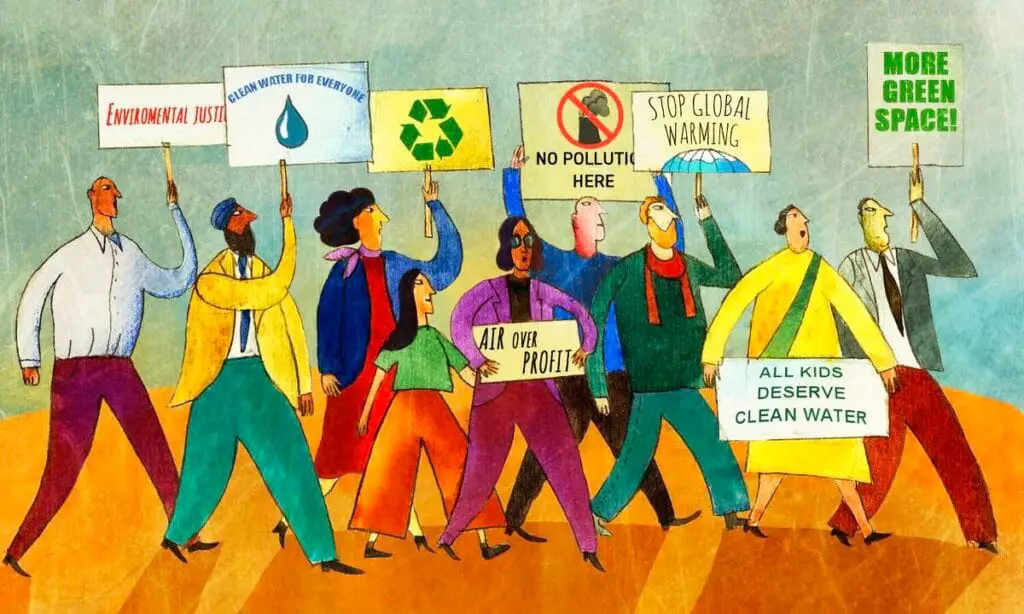What is Enviromental Movements & Discuss It’s Feature’s
Environmental movements are social and political efforts aimed at protecting the natural environment and promoting sustainable practices to ensure the well-being of the planet and its inhabitants. These movements have gained significant traction over the past few decades due to increasing awareness of environmental degradation, climate change, and the need for conservation.
Meaning
Environmental movements encompass a wide range of activities, organizations, and advocacy efforts that seek to address environmental issues. These movements can be local, national, or global in scope and often involve collaboration between various stakeholders, including non-governmental organizations (NGOs), governments, communities, and individuals. The ultimate goal is to create a sustainable relationship between humans and the environment, reducing the negative impact of human activities on the planet.

Here’s a breakdown of the meaning and key features of environmental movements :
Key Features
- Conservation and Preservation:
- Conservation: Focuses on the responsible management of natural resources to prevent their depletion. This includes efforts like sustainable agriculture, water management, and protecting endangered species.
- Preservation: Emphasizes protecting natural areas from human interference, often through the establishment of national parks, wildlife reserves, and marine protected areas.
- Advocacy and Policy Change:
- Environmental movements often work to influence public policy and legislation to promote environmental protection. This includes lobbying for laws that reduce pollution, promote renewable energy, and protect ecosystems.
- Public Awareness and Education:
- Raising awareness about environmental issues is a core activity of environmental movements. This is achieved through campaigns, educational programs, and media outreach that inform the public about issues like climate change, deforestation, and pollution.
- Sustainable Development:
- A key focus of many environmental movements is promoting sustainable development, which seeks to balance economic growth with environmental protection. This involves advocating for practices that reduce the carbon footprint, minimize waste, and promote the use of renewable resources.
- Grassroots Activism:
- Many environmental movements start at the grassroots level, with local communities organizing to address specific environmental issues in their area. These movements can grow to have a broader impact and often serve as a catalyst for larger, global environmental initiatives.
- Climate Action:
- In recent years, climate change has become a central focus of environmental movements. Activists work to combat global warming by advocating for the reduction of greenhouse gas emissions, transitioning to renewable energy sources, and preparing communities for the impacts of climate change.
- Biodiversity Protection:
- Environmental movements prioritize the protection of biodiversity, recognizing the intrinsic value of all living species and the need to maintain healthy ecosystems. This involves efforts to protect habitats, combat deforestation, and prevent species extinction.
- Environmental Justice:
- Many environmental movements emphasize the need for environmental justice, ensuring that all people, regardless of race, ethnicity, or socio-economic status, have access to a clean and healthy environment. This includes addressing environmental racism and advocating for the rights of marginalized communities disproportionately affected by environmental degradation.
- Anti-Pollution Efforts:
- Movements often focus on reducing pollution in air, water, and soil. This includes campaigning against industrial pollution, promoting cleaner technologies, and advocating for waste management practices that minimize environmental harm.
- International Collaboration:
- Environmental movements frequently operate on a global scale, recognizing that many environmental issues, such as climate change and ocean pollution, require international cooperation. Organizations and governments work together through treaties, agreements, and collaborative projects to address these global challenges.
Examples of Environmental Movements

- The Green Movement: Advocates for ecological sustainability, often associated with political parties that prioritize environmental issues.
- The Conservation Movement: Focuses on protecting natural resources and biodiversity, with roots in the early 20th century.
- The Climate Justice Movement: Combines social justice with climate action, emphasizing the need to address the disproportionate impact of climate change on vulnerable populations.
- Extinction Rebellion: A global movement using non-violent civil disobedience to pressure governments to act on the climate and ecological emergency.
- Fridays for Future: A youth-led movement, inspired by Greta Thunberg, advocating for urgent action to address climate change.
Environmental Movements continue to evolve, responding to new challenges and opportunities as the global community grapples with the complex relationship between human society and the natural world.
Share this content:



Leave a Reply